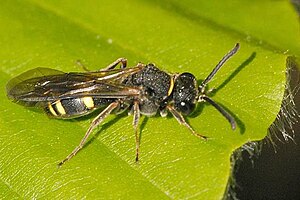Nysson
| Nysson | ||||||||||||
|---|---|---|---|---|---|---|---|---|---|---|---|---|

Nysson spinosus |
||||||||||||
| Systematics | ||||||||||||
|
||||||||||||
| Scientific name | ||||||||||||
| Nysson | ||||||||||||
| Latreille , 1802 |
Nysson is a genus of digger wasps (Spheciformes) from the family Crabronidae . The genus is represented with 56 species in the Palearctic . There are 37 species in Europe, 13 also in Central Europe.
features
The small to medium-sized species have a short and stocky black body. In some species the abdomen has yellow or white spots or is black with red. Some species look similar to their hosts . Species identification is usually difficult.
Way of life
All species live as parasitoids in the genera Gorytes , Harpactus and Argogorytes . Nysson species are generally rare and their relationship with host animals has not been fully explored. This is difficult, however, because the females, like the other hymenoptera parasitic species, often examine nests of different species and stay there longer, but do not lay eggs. The females are usually found near the nests of their hosts, where they fly or run around just above the ground. If a host is discovered at the nest, the female waits until it leaves and then enters the nest to lay an egg. However, it has also been observed that the females invade the nest when the host female is still there. As a rule, the host females do not recognize the parasitoid egg, but rather prepare provisions for their nest. However, the host females are alarmed when the Nysson females appear . Female harpactus also try to chase them away. Closed nests are dug up and then properly closed again. The eggs are laid on a prey animal lying above, always hidden either on the underside of the shield of the pronotum or under a wing or behind the rear hips ( coxes ). The eggs are much smaller than those of their hosts. The parasitoid larva hatches earlier than that of its host. With their long, thin mandibles, the host egg is first sucked out and then the prey brought in by the host female is eaten. Pupation takes place in a cocoon , which looks similar to that of the host species.
Species (Europe)
- Nysson alicantinus Mercet 1909
- Nysson bohemicus Zavadil 1848
- Nysson castellanus Mercet 1909
- Nysson chevrieri cabbage 1879
- Nysson dimidiatus Jurine 1807
- Nysson dusmeti Mercet 1909
- Nysson fraternus Mercet 1909
- Nysson fulvipes A. Costa 1859
- Nysson ganglbaueri Kohl 1912
- Nysson gerstaeckeri Handlirsch 1887
- Nysson hrubanti Balthasar 1972
- Nysson ibericus Handlirsch 1895
- Nysson interruptus (Fabricius 1798)
- Nysson kolazyi hand deer 1887
- Nysson konowi Mercet 1909
- Nysson lapillus Beaumont 1965
- Nysson Laufferi Mercet 1904
- Nysson maculosus (Gmelin 1790)
- Nysson miegi Mercet 1909
- Nysson mimulus Valkeila 1964
- Nysson niger chevrier 1868
- Nysson parietalis Mercet 1909
- Nysson pratensis Mercet 1909
- Nysson pusillus Beaumont 1953
- Nysson quadriguttatus Spinola 1808
- Nysson roubali Zavadil 1937
- Nysson ruthenicus Birula 1912
- Nysson spinosus (J. Forster 1771)
- Nysson susterai Zavadil 1948
- Nysson tridens Gerstaecker 1867
- Nysson trimaculatus (Rossi 1790)
- Nysson varelai Mercet 1909
- Nysson variabilis Chevrier 1867
- Nysson decemmaculatus (Spinola 1808)
- Nysson epeoliformis (F. Smith 1856)
- Nysson militaris (Gerstaecker 1867)
- Nysson monachus (Mercet 1909)
supporting documents
Individual evidence
- ↑ a b c d Manfred Blösch: The digger wasps in Germany: way of life, behavior, distribution . 1st edition. Goecke & Evers, 2000, ISBN 3-931374-26-2 , pp. 361 f .
- ^ Nysson. Fauna Europaea, accessed July 24, 2010 .
literature
- Manfred Blösch: The digger wasps in Germany: way of life, behavior, distribution . 1st edition. Goecke & Evers, 2000, ISBN 3-931374-26-2 .